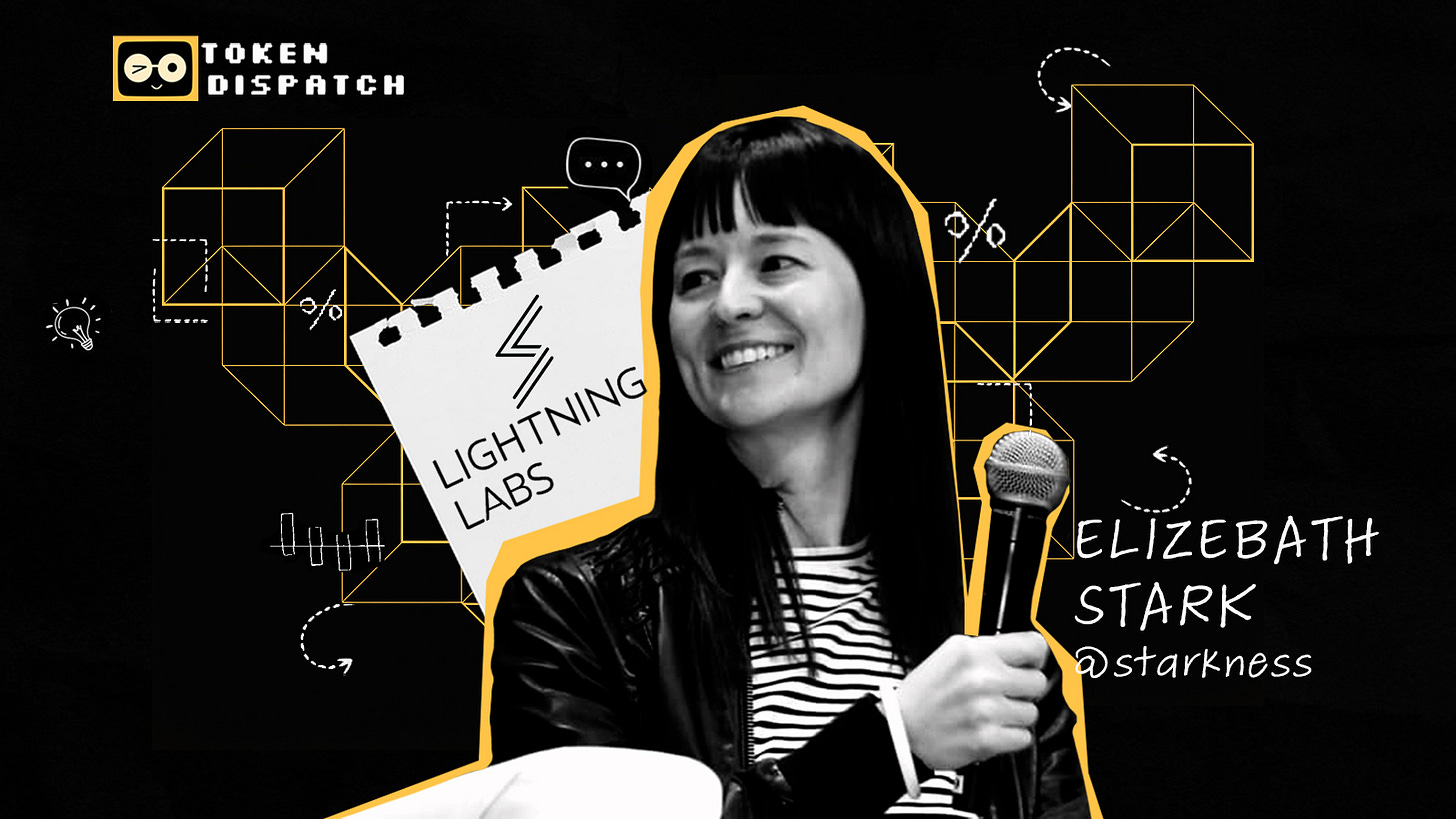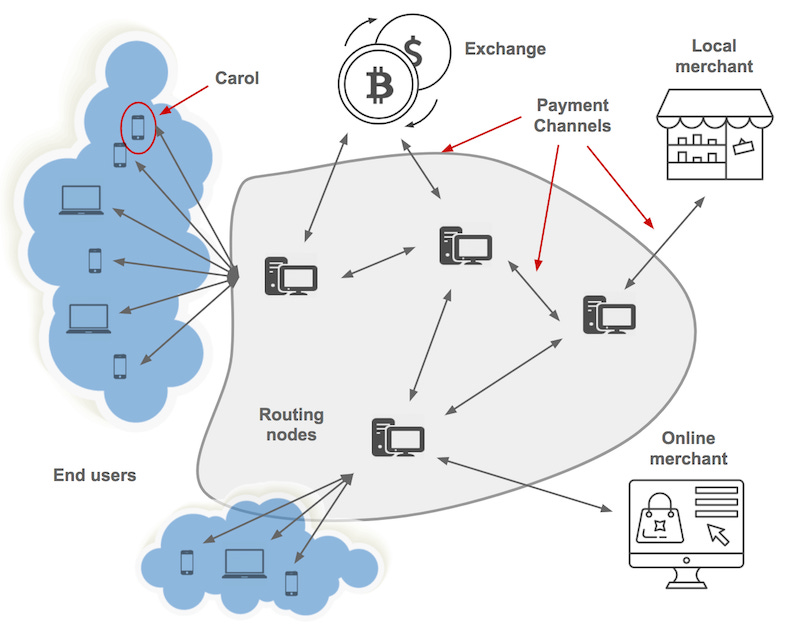Elizabeth Stark: Why Bitcoin Needed a Lawyer ⚡
From fighting SOPA to scaling cryptocurrency transactions.
The trademark lawsuit arrived on a Tuesday in March 2023.
Elizabeth Stark was watching her company's biggest product launch crumble in real time. Lightning Labs had spent years building "Taro," a protocol that would let people send stablecoins over Bitcoin's Lightning Network. The technology worked. The community was excited. Major partners were lined up.
Then a judge issued a temporary injunction. Tari Labs claimed they owned the "Taro" trademark. Lightning Labs had to stop using the name immediately. No more development announcements or marketing.
The rebrand to "Taproot Assets" took weeks of scrambling. Months of momentum vanished overnight; partners had to explain the name change to confused customers. Some questioned whether Lightning Labs had done proper trademark research before launching such a major initiative.
But Stark pushed forward anyway. The technology continued to develop under its new name, even as competitors gained ground during the forced pause.
She's built one of Bitcoin's most important infrastructure companies. Stark's work is aiming to reshape how Bitcoin functions, but the jury's still out on whether her vision will actually work at a global scale.
Tired of Complicated Wallets and Sketchy Spending Methods?
Meet Ready:
Self-custodial (you control your keys), no seed phrase required
Spend USDC with zero fees, Mastercard accepted worldwide
Up to 10% cashback + solid perks and peace of mind
Crypto that’s easy, secure, and actually usable. Start with Ready today
Before Elizabeth Stark built Bitcoin infrastructure, she learnt how to fight much bigger opponents than trademark holders.
Harvard Law School, 2011. Stark was organising a grassroots campaign to kill two bills moving through Congress with bipartisan support.
SOPA and PIPA would let copyright holders force websites offline for alleged infringement.
What are they?
SOPA (Stop Online Piracy Act) and PIPA (Protect IP Act) were proposed US laws aimed at fighting online piracy by letting copyright owners force websites accused of infringement offline. The bills would have allowed blocking a website’s access to advertising, payment processing, and search engines. This could have shut down sites even outside the US jurisdiction. Many feared the laws would lead to widespread internet censorship, harming legal websites and free speech.
Social media platforms, search engines, and user-generated content sites would face constant legal threats. Most tech companies were too scared to oppose the legislation directly, worried about antagonising lawmakers.
Stark co-founded the Harvard Free Culture Group and helped coordinate protests across campuses. The message was that these bills would break the internet by making platforms liable for user content they couldn't possibly monitor.
"This wasn't Google v Hollywood," she explains. "This was 15 million internet users v Hollywood."
Wikipedia blacked out for 24 hours. Reddit shut down. Protesters flooded congressional phone lines. Within days, lawmakers backed away from the bills. SOPA and PIPA died in committee.
The campaign taught Stark that sometimes you couldn't beat institutions through traditional channels, but you could make their preferred solutions politically impossible.
During law school, she also founded the Open Video Alliance and produced the inaugural Open Video Conference. The first event drew 9,000 participants, proving demand existed for alternatives to traditional media gatekeepers. But organising conferences and fighting bad legislation felt reactive. After graduating, Stark took academic positions at Stanford and Yale, teaching how the internet was reshaping society and economics. She researched digital rights and worked with policy organisations to develop better frameworks around emerging technologies.
Policy solutions always played catch-up to technological change. By the time lawmakers understood new technologies well enough to regulate them properly, those technologies had evolved into something else entirely.
What if you could build technologies that were resistant to bad regulation from the start?
The Bitcoin Wars
In 2015, the Bitcoin community was fighting over its future.
The "blocksize wars" had been raging for months. Bitcoin could only process about seven transactions per second, nowhere near enough to compete with traditional payment networks. One faction wanted bigger blocks to fit more transactions. Another preferred to keep blocks small to maintain decentralisation.
The debate was existential. Would Bitcoin remain decentralised, or become controlled by mining operations and corporate interests?
Elizabeth Stark watched the fight with fascination. She'd seen similar battles in internet governance, where technical decisions had political implications. But Bitcoin was different. No central authority could impose solutions. The community had to reach consensus through code and economic incentives.
As the debate intensified, developers proposed a different approach: build a second layer on top of Bitcoin that could handle millions of transactions per second while preserving the base layer's security.
The Lightning Network.
Instead of recording every transaction on Bitcoin's blockchain, users could open payment channels and settle multiple transactions off-chain. Only opening and closing channels would require blockchain transactions.
These channels could link together. If Alice had a channel with Bob, and Bob had one with Carol, Alice could pay Carol by routing through Bob. The network would become an interconnected payment channel processing instant, low-fee transactions.
Stark saw the potential, but also the challenges. Lightning was still theoretical. The technology required complex cryptographic protocols that hadn't been tested at scale. Most Bitcoin users didn't understand why they needed second-layer solutions.
In 2016, she co-founded Lightning Labs with programmer Olaoluwa Osuntokun. The timing was risky, but Stark had learned from activism that the best time to build alternatives was before everyone realised they needed them.
Building Infrastructure
Lightning Labs shipped the first Lightning Network beta in 2018. The software was rough; channels failed regularly, liquidity management was confusing, and most wallets couldn't integrate the technology properly.
But it worked. Users could open channels, make instant payments, and close channels without waiting for blockchain confirmations. The early adopters were mostly developers who understood the technology's potential.
Stark wanted to serve billions of people without reliable financial services. Her team focused on practical problems real users faced.
How do you manage channel liquidity so payments don't fail? Lightning Loop let users move funds between channels and the blockchain without closing channels, solving some liquidity problems but not all of them.
How do you create markets for liquidity? Lightning Pool built a marketplace where people could buy and sell channel capacity, though adoption remained limited to sophisticated users.
How do you run Lightning on mobile without killing battery life? Neutrino enabled privacy-preserving light clients, but the technology was still too complex for mainstream apps.
Each product tackled specific infrastructure pieces. Progress was slow; Lightning remained difficult to use for non-technical people. Channel management required constant attention. Payments failed regularly when routing couldn't find paths with sufficient liquidity.
But the foundation was getting stronger. Major wallets started integrating Lightning. Payment processors began offering Lightning services. The network grew from dozens of nodes to thousands, though most of the capacity concentrated in a few large hubs.
Critics pointed out that Lightning's hub-and-spoke topology wasn't as decentralised as advertised. They questioned whether the technology could scale without becoming controlled by major payment processors. Stark acknowledged these concerns but argued that Lightning was still early; better solutions would emerge as the technology matured.
The Stablecoin Bet
By 2022, stablecoin volume was exploding. Tether and USDC were processing over $1 trillion annually, more than many traditional payment networks. But most stablecoins ran on Ethereum and other blockchain networks that weren't as secure as Bitcoin.
Stark saw an opportunity. Lightning Labs raised $70 million to build what became Taproot Assets, a protocol for issuing and transferring stablecoins on Bitcoin. The technology used Bitcoin's Taproot upgrade to embed asset data in regular transactions, making stablecoin transfers look like normal Bitcoin payments.
These assets could move over Lightning Network. Users could send dollars, euros, or other assets instantly while benefiting from Bitcoin's security. Every stablecoin transaction would route through Bitcoin liquidity, potentially increasing demand for Bitcoin and generating fees for node operators.
"We want to bitcoinise the dollar," Stark explained, though whether people actually wanted their dollars bitcoinised remained unclear.
Why? While the technology enables dollar-denominated stablecoins on Bitcoin, the broad user base for stablecoins largely remains on Ethereum and other more mature ecosystems where infrastructure, liquidity, and developer activity are deeper, making Bitcoin stablecoins still niche.
Bitcoin maximalists sometimes question adding non-Bitcoin assets on Bitcoin, reflecting ideological hesitancy or preference to maintain Bitcoin as pure “digital gold” rather than a multi-asset settlement layer.
Users in emerging and inflationary markets desire stablecoins for stability, but adoption on Bitcoin Lightning requires overcoming complexity, liquidity, and user experience barriers compared to established stablecoin rails. The market is still determining product-market fit for stablecoins on Lightning, so demand to "bitcoinise the dollar" at scale is aspirational but not certain yet.
However, the trademark dispute forced the “Taro” rebrand, but development continued. By 2024, Lightning Labs had shipped Taproot Assets and begun processing real stablecoin transactions. Bridge services moved USDT from Ethereum to Bitcoin's Lightning Network; users could send dollars for pennies.
But adoption was limited. Most stablecoin users stayed on Ethereum where the ecosystem was more developed. Bitcoin maximalists questioned whether bringing other assets to Bitcoin was necessary or desirable. The technology worked, but product-market fit remained elusive.
The Network Effect Question
Today, Lightning Labs runs important Bitcoin infrastructure, by developing and maintaining LND (Lightning Network Daemon), the leading software implementation for the Lightning Network that powers the majority of Bitcoin’s layer-two payment channels. But Elizabeth Stark's bigger vision remains unproven. She describes building "the internet of money" where financial services operate globally without permission from governments or corporations.
The comparison to Internet protocols makes sense in theory. Just as anyone can build websites and applications on internet protocols, anyone could build financial services on Lightning protocols. The network would be open, interoperable, and censorship-resistant.
But networks are only valuable if people use them. Lightning adoption grows fastest in countries with unstable currencies or unreliable banking, but even there, uptake is measured in thousands rather than millions of users. Remittance companies experiment with Lightning, but most still use traditional rails for the bulk of their business.
Stark's team works on AI integration for autonomous payments, privacy improvements, and educational resources for developers. Each advancement is technically impressive, but mainstream adoption feels perpetually just around the corner.
"Bitcoin is a movement," Stark says. "Everyone here is part of building an entirely new financial system."
The movement exists, but its impact on everyday people remains limited. Lightning processes thousands of transactions per second in theory; in practice, most people still pay with credit cards and bank transfers. Whether Bitcoin payments will ever feel as natural as sending emails depends on solving user experience problems that have persisted for years.
But Lightning is still pretty far from the 'as easy as sending an email' vision that Stark talks about. Managing channel liquidity is like being your own bank's operations department — you need to constantly monitor whether you have enough money on both sides of your payment channels or transactions just fail. Payment routing can break when there isn't enough liquidity along the route, which happens more often than you'd want. Setting up Lightning is still the kind of thing that requires reading documentation and understanding concepts like 'inbound capacity.' Most people just want to tap a button and send money, not become amateur liquidity managers.
Lightning Labs has spent that $70 million on building Taproot Assets, improving their node software, and trying to convince developers to build Lightning applications. Taproot Assets is meant to let stablecoins and other tokens flow through Lightning channels, which could matter if people actually want to send stablecoins through Bitcoin infrastructure instead of just using existing stablecoin networks. They've also been working on making their LND software less terrible to use and trying to educate developers about why they should care about Lightning. Whether any of this leads to normal people actually using Lightning for normal payments is still an open question.
The technology works, but 'works' and 'works well enough for your mom to use it' are different things.
That’s it about Stark. See you next week with another one.
Until then.. stay awesome.
Token Dispatch is a daily crypto newsletter handpicked and crafted with love by human bots. If you want to reach out to 200,000+ subscriber community of the Token Dispatch, you can explore the partnership opportunities with us 🙌
📩 Fill out this form to submit your details and book a meeting with us directly.
Disclaimer: This newsletter contains analysis and opinions of the author. Content is for informational purposes only, not financial advice. Trading crypto involves substantial risk - your capital is at risk. Do your own research.







